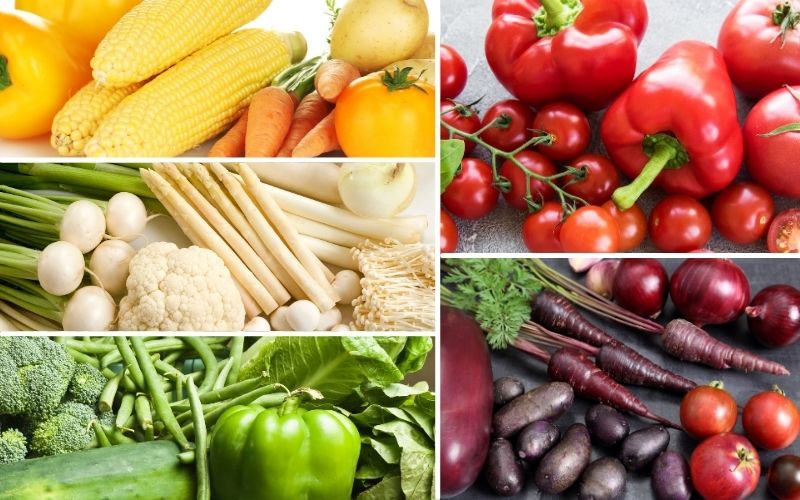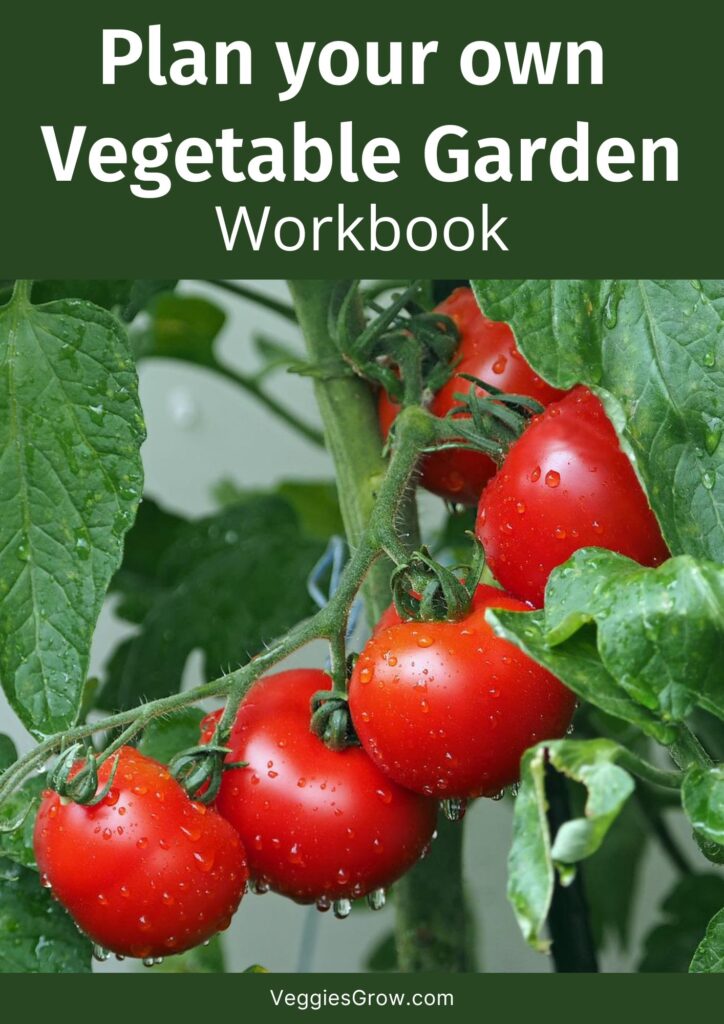Taking the time to choose the types and varieties of vegetables that you will be growing this season is an important step in planning your vegetable garden. This post will guide you through 4 easy steps that will help you choose to grow vegetables that you will enjoy and that will grow most easily in your garden this season.
Step 1: Make a wish list of vegetables you would like to grow
You can start by creating a list of vegetables you would like to grow. Here are a few different categories of vegetables you might like to add to your wish list.
- Vegetables you usually eat
You can look at your weekly grocery list or just pay a little more attention to what vegetables you have the most on your plate and which you enjoy the most.

- Vegetables you would like to eat
There may be vegetables that you don’t currently eat regularly but would like to add to your diet. Maybe there are some new recipes you want to try or a new diet that you’re on that demands you to eat more specific types of vegetables.
There may also be other vegetables that are not commonly available at your grocery store. Add all these vegetables to your list.
You can also visit your local farmer’s market to have a look at a live catalog of options available for you. If any of these vegetables are not on your list and you think you may like to grow them, go ahead and add them.
- Vegetables you have grown before
There may be vegetables that you have successfully grown and want to grow again. Make sure that they are on the list or add them. Your previous years’ experience will make growing this year’s vegetable garden less of a learning curve and will free-up time to concentrate on vegetables that will be more challenging to grow.
If you were not that successful in growing some vegetables but would like to have another try, go ahead and add them to your list. Remember, “There are no gardening mistakes, only experiments”. – Janet Kilburn Phillips.
If you are a complete beginner don’t worry, you will have a list of your own successes next year. Just remember to keep a gardening journal and record your progress.
Step 2: Choose vegetables that are suitable for your climate and growing season
Next, you will need to narrow down your wish list of vegetables by removing vegetables that are not suitable to be grown in your local climate or during the growing season you are planning for.
Warm-season vegetables:
- Prefer a mean temperature of 18-30°C during growth and development.
- Intolerant of frost.
- The edible parts are usually fruits or fruit products.
- Examples are summer vegetables, such as tomatoes, eggplant, melons, and beans.
Cool-season vegetables:
- Prefer a mean growing temperature of 10-18°C.
- Some are frost and freeze tolerant.
- The edible parts are usually the leaves, stems, and roots.
- Examples are cabbage, lettuce, spinach, beetroot, and carrot.
If you live in an area with distinct seasons, you can choose vegetables that are particularly suitable for the season that you want to grow in. You can mark vegetables that need to be grown in another season and keep them for later reference.
If you live in an area that is tropical or subtropical and without distinct seasons, you may be limited to growing only either warm-season vegetables or cool-season vegetables depending on the elevation of your location.
You can narrow down your list even further by choosing varieties of those vegetables that have been developed particularly for your country or climate. You can ask other gardeners near you or your local gardening center or agricultural extension office for advice.
Step 3: Choose vegetables that are a great fit for your own vegetable garden
The easiest vegetables to grow are vegetables that are a great fit for the characteristics of your own vegetable garden. As a beginner, choosing the easiest vegetables to grow will give you a head-start on your gardening journey. Then, once you are more experienced you can experiment with more challenging vegetables.
Choosing plants that are suitable for each microclimate in your garden will ensure that your plants are healthy and as productive as possible.
A few of the characteristics of your vegetable garden that you should take note of are given below.
- The amount of sunlight or shade

Not enough sunlight can be a big issue in temperate areas even in completely open gardens. Although this is usually not an issue in tropical climates, man-made structures can severely block sunlight and cause plants to be less productive even if they do grow.
Not getting an even amount of sunlight is a common problem for balcony gardens. One part of the balcony may get a lot of sunlight, while another may be in complete shade.
Additionally, if plants are grown close together, the taller plants may eventually cover shorter plants and block sunlight from getting to them.
Vegetable plants will not grow in completely shaded areas but will grow in areas that get at least 4 hours of sunlight a day. Different types of vegetable plants have minimum sunlight requirements.
8 hours of sun: Fruiting vegetables – tomato, pepper, melons, sweet corn
6 hours of sun: Root vegetables – carrots, beetroot
4 hours of sun: Leafy vegetables – lettuce, spinach
On the contrary, too much sunlight can damage plants and give them sunburn. Although only shade-loving plants may suffer from sunburn in cooler climates, in warmer climates rooftops and balconies may get too much direct sunlight making it unsuitable for any vegetable plant. If you recognize that you have areas like this on your rooftop or balcony, you should avoid these areas or protect your plants using shade cloth.
- The soil in your garden
Choosing vegetables that are suitable for your soil structure and moisture level is very important if you plan on growing vegetables directly in the soil. Well-draining loamy soil is the best for most vegetables, but some vegetables will do alright or even well in sandy, clay or waterlogged soil.
Clay soil: cabbage, beans, potato, broccoli
Sandy soil: carrot, beetroot, onion, potato, and other vegetables and herbs that are suitable or will tolerate sandy soil
Waterlogged soil: cauliflower, celery, spinach, groundnut, kang kong (kang kung), arugula, watercress
Although various soil amendments can be added to change the pH and nutrient level of your soil, choosing the most suitable vegetables will make garden care and maintenance easier.
Alternatively, you can use raised beds or containers to grow plants that are not very suitable for your garden soil if they suit your local climate and the microclimatic conditions of your garden.
Step 4: Choose the best mix of vegetables to grow
Only certain parts of vegetable plants are edible. For example, only the tubers of the potato plant are eaten, while only the fruits of the tomato plant are eaten. Choosing to grow a mix of different types of vegetables will add variety to your food and will give you a good balance of nutrients.
Vegetable plants can be divided into different families based on the characteristics that they share. Growing vegetable plants from different families together will help you create healthier soil and plants. Companion planting and crop rotation (see below) are organic practices that are mainly based on this classification.

- Nutritional Value
Vegetables vary quite a bit in their nutritional value. The color of a vegetable roughly reflects the nutrients it contains. An easy way to eat vegetables with different nutrients is to grow and eat different colored vegetables.

- Companion planting
Companion planting is a system in which certain plants that mutually benefit each other are grown together. These plants may also include flowering plants that are not usually eaten but are grown together with vegetable plants to attract pollinators.
Benefits of Companion Planting a Vegetable Garden
On the other hand, some plants should not be grown together. For example, fennel should be grown away from other vegetables as it tends to inhibit the growth of vegetable plants near it.
- Crop rotation
Crop rotation may not be something that you need to worry about as a complete beginner. Some vegetables have similar nutrient requirements and are affected by similar pests and diseases. Avoiding growing these groups of vegetables in the same area of your garden repeatedly has many benefits.
What is crop rotation and why is it important?
This post is part of a series of blog posts on the 7 steps of planning a vegetable garden. You can download the FREE workbook ‘Plan Your Own Vegetable Garden’, which will provide you with more information on each of these 7 steps and help you plan your own vegetable garden.



Another really useful post, thanks!
I’m dreaming of planting my garden (while it’s snowing outside). This is super helpful! Thanks for sharing.
I am loving this post. Last year was the first time we planned veggies in our back yard and we enjoyed the result.